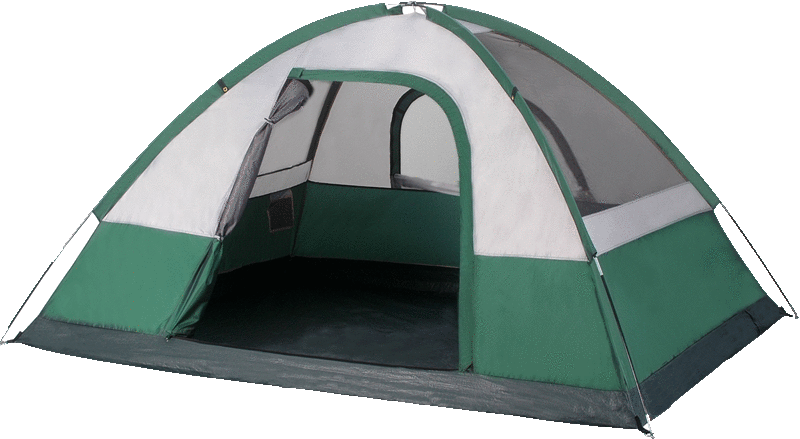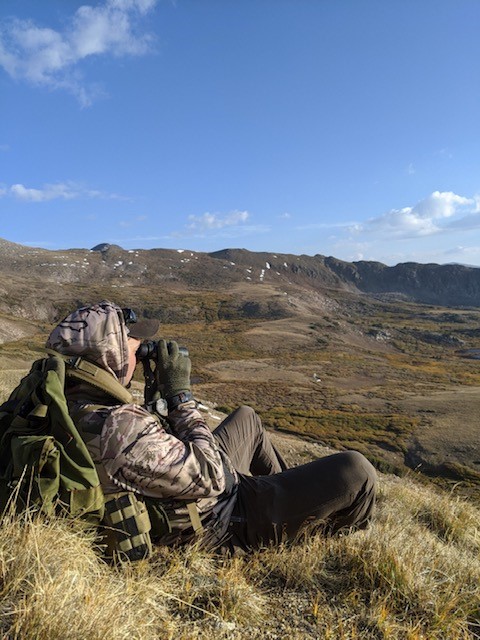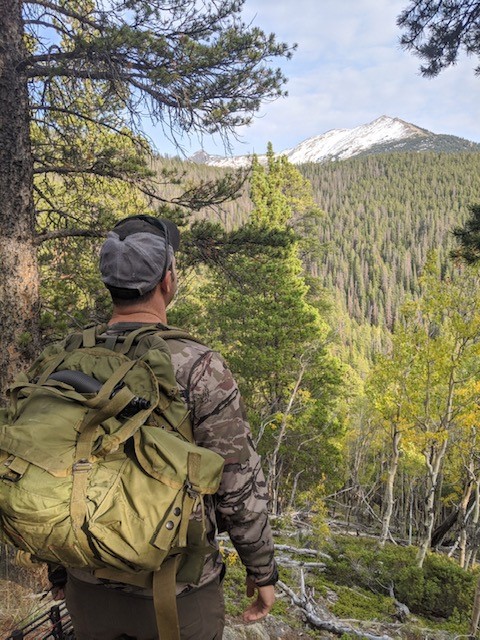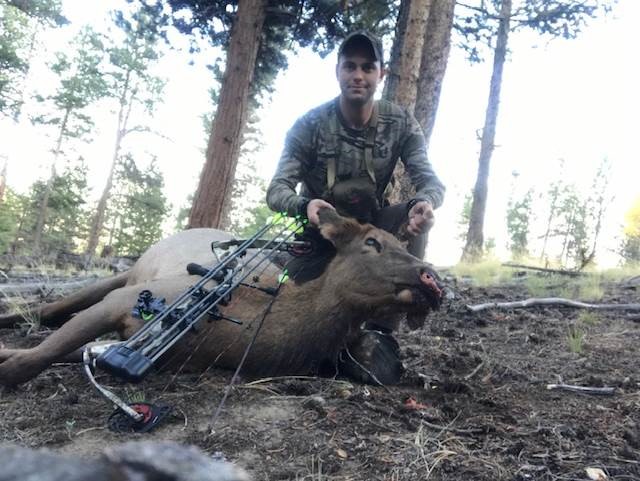This was the year. My good friend Sam I had known since middle school just
returned from a little “fun in the sun” deployment to the Middle East. With
Sam back in Colorado Springs with me, we excitedly started planning our fall
hunting adventures. The goal was to maximize our time in the field this year.
Archery elk, rifle pronghorn and rifle deer; we put in for the same areas and
anxiously waited. Fortunately, we both drew tags out on the plains about two
hours east of the Springs for rifle pronghorn and rifle mule deer.
Unfortunately, only I was drawn for elk: an either sex tag for a unit just
west of the great little town of Buena Vista, with BV about a two-hour drive
for us. I was in for a busy season! We were excited for what the season had
in store for us.
There was only one problem. Sam and I are both in the Army and Uncle Sam gets
his say. In June, Sam abruptly came down on orders to North Carolina. He
needed to be there by early September, right at the beginning of the hunting
season! Looks like I’ll be out on my own again this year…. or so I thought.
The painful bureaucracy and many levels of Army approvals for travel during
COVID-19 worked in our favor. The Army delayed Sam’s departure again and
again. Early September turned into late September, which turned into early
October, turned into late October, when he would finally be on his way.
With this delay, I would have a hunting buddy for my elk hunt! Sam is a good
friend. Even without his own tag, Sam volunteered to join me for almost the
entirety of my elk excursion. Sam was even able to squeeze in his first
antelope hunt this year. That story was in last month’s issue.
Thursday after work, I had everything ready to go. The gear was packed,
cooler iced up and radio check complete with Sam. I headed out late Thursday
afternoon to set up camp and get the lay of the land. Sam had to work on
Friday. He would join me Friday evening. I picked a heavily wooded section
of the unit that was several miles back on a dirt road to make camp for the
first night. By the time I got to the general hunting area, the sun was
setting, so I stopped to make camp. With the last bit of light at dusk
quickly slipping away, I verified my bow at 30 yards, scarfed down some
dinner and climbed into my roof top tent.
I was on the move before sunup, the morning was quiet with a good chill in
the air. Camped in the low ground at around 10,250 feet, I made my way up
to about 11,300 feet by mid-morning. Because of the thick brush, I could
only see 50 yards. Never having hunted this unit or even the opportunity
to scout it, I spent the afternoon exploring. The entire western area from
Buena Vista is littered with several 14,000-foot mountains and steep
mountainous terrain. This of course had its pros and cons; it meant lots
of elevation to explore and hopefully less pressure from other hunters.
However, the negative side of this area was the accessibility. 13-14k foot
mountains stood between every part of the unit, not something that we could
travel through in a day. That meant lots of back-tracking to town and taking
the highways from one side of the unit to the other.
After linking up with Sam, we decided to try a different section of the unit
near the northern boundary. Just before dusk, we settled on a camping spot
and glassed the area intermittently as we explored the area on foot. It was
a gorgeous valley, a narrow corridor with steep sides. From the valley floor
and up the sides of the valley were tall pines and thick dark timber. Beyond
halfway point the trees started to disappear into sub-alpine rock fields
trapped by snowcapped peaks. It seemed like a promising area.
Ten minutes into our evening hunt and we stumbled upon a camp of “Texans”
there hiking several of the fourteeners in the area, they were blasting music
and enjoying cooking up a feast as we strolled through to talk to them. They
were very inviting and even offered us campfire enchiladas. However, they
had not seen any elk in the five days that they had been camped in the valley.
“Damn” we thought. Sam and I discussed our options as we moseyed back to camp.
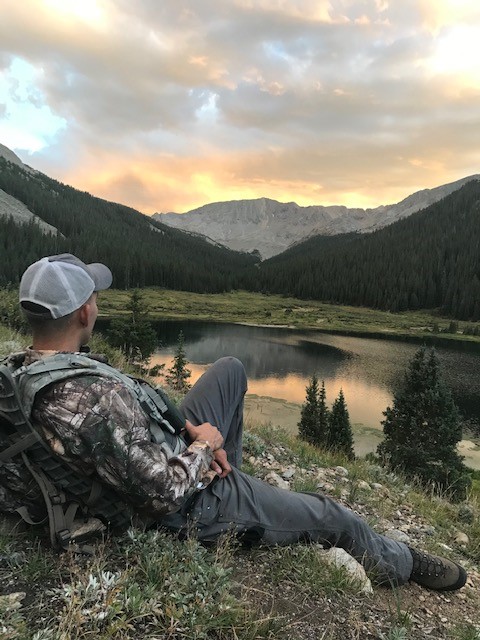
Sam looking out over the alpine lake
|
The next morning, we decided to still explore the area we were already in, and
we hiked a little over a mile to a small alpine lake. We spent the morning
getting high above the lake and glassing the surrounding area. It was a quiet
morning, so by 9:30 am we decided to try our hand at fishing. On my second or
third cast I hooked a small rainbow trout. It was not big enough to keep, so
I set it back in the water and we headed out to find another area to hunt.
That afternoon we tried lower elevations. The alpine lake was at 11,000 ft and
we had not seen any fresh sign. We headed out to a new area and after a couple
hours of driving on overgrown dirt trails, we found a nice, secluded camping spot
in a dark timberline. That evening Sam and I split up for the evening to cover
more ground. It was a quiet evening with no other hunters in the area and no
wind. Except for a doe mule deer, there was no activity that evening.
The next morning, we revisited the same area I hunted the night before. It was
a long clearing a little over 300 yards with tall grass and a little stream
running through itand surrounded by thick timber. There was a ton of sign all
over the field and the surrounding hills, but no elk to be found.
It was Sunday and we both decided to head back in the afternoon and try again
another weekend. There was still plenty of time left in the season and much of
the unit was still unexplored; we’d soon be back at it again.
A couple weeks later I was back out in the woods. Like last time, I headed out
Thursday after work and set up camp. Friday evening, I met up with Sam and we
picked a new area to try. This was in the same general area as where we ended
on our previous excursion. The next morning, we started hiking before sunup and
spent the morning getting our workout in. We hiked for a couple hours on what
seemed like an endlessly uphill trail, ending at an overlook. However, the dense
pine timber was extremely thick. Without any clearings or notable terrain
features that we could watch, we moved on to the next area.
For our next area, we drove to the opposite side of the unit, one area I have
been to in the past. The only way to access this side is through a popular 4x4
trail, which is frequented by off-road buggies and a whole host of local rigs.
We hoped to catch a quick opportunity when traffic was light in the early morning
or late evening. As we were setting up camp, a bull moose appeared without a
sound 100 yards from where we were camped. He didn’t seem bothered by us in the
slightest bit.
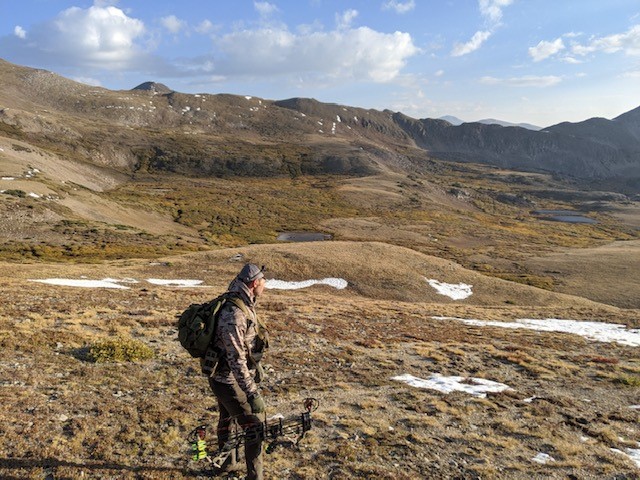
|
The next morning, we decided to gamble and head even higher up the mountains in
hopes we might catch sight of a herd of elk. We headed out at daybreak from our
camp which was at 11,765 ft and climbed up to a nearby peak sitting at 13,000 ft
of elevation. The first mile we side-hilled through the sub-alpine forest which
remined me so much of the coastal Alaska landscape. Large pines, rich undergrowth
and an abundance of small streams. At the top, the winds were whipping. We
hunkered down to take in the scenery and spend some time behind the binoculars.
As we made our way off the exposed peak, Sam and I reflected on the hunt so far.
Elk hunting is never an easy task. Everything about it is hard work. You must
plan and prepare ahead of time. The hunt itself requires hearty effort to
overcome the challenges along the way. We joked that we had put in the work,
six days and dozens of vertical miles; surely we had earned it. Despite this
work, we had yet to see a single elk or any significant amount of fresh sign.
It was never just that easy. As we descended the 13,000 ft peak, our optimism
grew because we had spent many days of hard hunting without any luck. That
meant we were soon due for a turn of events!
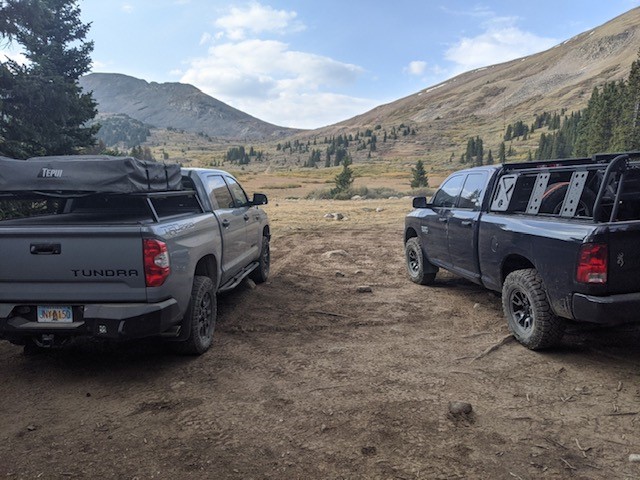
Packed up, ready to make the drive back over the mountains
|
But that turn of events would have to wait for another weekend. It was again
Sunday afternoon, which meant we would need to head home for the upcoming work
week.
We decided to take a different trail off the mountain and had a great end to
the weekend off-roading on another one of Colorado’s fantastically scenic
trails. We ended at a lake and had a late lunch before making the drive back
to Colorado Springs.
I spent most of the drive racking my brain on what we could have done
differently and more importantly, where could the elk possibly be?
The last weekend of archery season, I set out again after work by myself on a
Friday evening. By this time, it was the fourth week in September. I knew
the elk were much more likely to be lower in elevation than where we had
previously hunted. By this time of the season the bulls would be gathering
their herds of cows and begin the rut.
I camped near one of the places we had previously hunted around 9,300 ft in
a heavily wooded section. The evening was quiet, I ate dinner and listened
to the woods in silence for a couple of hours. Aside from the very slight
breeze that would whistle through the pines from time to time, the woods
were quiet. I had yet to hear even a bugle or any serious action in the
woods. I was a bit discouraged. I had not even packed any real food for
breakfast or lunch the next day because I was convinced that I would not
see anything. I told myself if I didn’t see an elk by the end of my morning
hunt on Saturday that I would head back early… Then I found the elk.
As I threw my ALICE rucksack over my shoulder, I heard the faintest bugle
in the distance. The bugle was far off. It sounded juvenile and possibly
an imitation. I was instantly elated, but I told myself “It’s probably
just a hunter, don’t get excited”.
I picked up my bow and strapped on my release just as bluish-grey morning
light began to illuminate the woods. I began hiking downhill. After
about 15 minutes, I happened upon another dirt road that I had never
investigated. This road led generally in the direction of the bugle.
After two minutes of silently and slowly creeping down the dirt road,
movement in the woods caught my eye.
I froze. Standing still in the middle of a dirt road, I saw an elk. I
slowly reached for my binoculars and scanned through the trees. At first,
I only saw three cow elk and briefly what looked to be antlers through the
brush. They were undisturbed and grazing on short grass, nonchalantly
moving generally in my direction. More and more elk began appearing like
ghosts in the morning light. I counted about 20 cows and at least one bull
and caught a glimpse of what I thought was a second bull.
I had a dilemma. I was still on the road, hiding behind a small scrub oak
bush. The closest elk was over 100 yards from me. The forest floor was
covered with the dry oak leaves and pine needles. There was no wind. I
had no chance of maneuvering on them without being busted by sound. My
only real option was to be patient and wait for them to come to me. I
nocked an arrow and continued to watch the small herd for several minutes.
Suddenly, the bull began to half-heartedly round up the cows. For a split
moment I brainstormed ways to beat the bull over the next hill and set an
ambush for him, like I had done so many times in Army Ranger School. There
were a lot of eyes and ears in the woods who would spoil my attempt. I
decided then not to go for the bull. I told myself “don’t be greedy, take
what comes to you and make it happen, forget about the bull.”
I stood with my range finder, checking ranges and looking for an opportunity
at a shot through the woods as the cows followed the bull to the hill. The
vegetation was not too dense, but my maximum range was 60 yards. I decided
ahead of time I would not shoot more than 60. I found my shooting lane
through the trees and my opportunity presented itself. A mature cow stopped
on a slight rise at exactly 60 yards and stopped broadside. I set my pin to
60 yards, drew my bow, took in a deep breath and held it. Release.
I saw her jump and then duck down right as the arrow made contact. I saw
the bright green color of the nock and fletching as she sprinted away from
me. The arrow looked to be very high in her shoulder, near the neck. I
breathed heavy as I processed everything. I had not made the perfect shot.
I was devastated. All I could think about was all the hours at the range,
the time spent visualizing my shot technique and all the preparation I had
done. I had made a poor shot.
But now was not the time for evaluation or reflection. Now was the time to
find my elk. When my arrow hit her, she ran almost directly away down into
a small draw out of sight. At the same time, the rest of the herd sprinted
up and over the hill towards their bull, long gone.
After just a couple of minutes, I investigated where she had stood on the
small rise and looked for a blood trail.This was a very much a mistake, one
I knew to avoid. I knew I should stay put for 20-30 minutes and let her calm
down. But I did not listen to myself and pressed on. As I moved over the
hilltop and descended into the small ravine, not more than 125 yards from
where I made the shot, I heard her spook. She sprinted off back into the
woods again, with my neon green arrow inside her. Stupid, I thought to myself.
I knew not to prematurely search for her when she is wounded and on high alert.
I then decided to hike 15 minutes in the opposite direction of where she ran
to keep myself from looking for her too soon.
After hiking for quite a while, I eventually made my way back to the place
I saw her last and began combing the area. I searched for hours and hours
until late morning with no luck. No blood trail and no sign of her.
Frustrated, I hiked back to my truck.
By now my poor packing and lack of food caught up with me. I drove down
the mountain into town to get lunch. I took some time to calm down and
re-evaluate the situation. I came up with two plans. First, I wanted to
go check out a small water hole near where I saw her last. My rationale
being that sometime in the late afternoon or early evening she would be
tired and thirsty and go there for a drink. Second, if I did not see her
at the water hole by late afternoon, I would go back and search the same
area again.
After a few hours of sitting on the water hole, I resumed my search.
This time, however, I pushed just a little further than I had previously
and over a distant hill. Nothing. The sun was just starting to dip below
the horizon. I planned to check one last area before calling it a day.
Then I saw her! She was laying on the side of a hill in plain view. I
made my way to her, ecstatic! Finally, with much time and energy spent,
the job was done.
She was about 300 yards from where I originally made the shot. When I
bumped and spooked her early in the day, she ran the opposite direction
of where I found her. It appeared that after she calmed down, sometime
in the morning, she made her way back to this hillside and eventually
expired. She had been dead for several hours by the time I found her
around sundown.
The arrow had hit her in the neck, not a great shot. It’s possible that
she moved at the sound of my bowstring, which caused the hit in the neck.
Possible. Perhaps also likely that I simply made a poor shot at 60 yards.
At dark, I began field dressing and quartering her on the side of the hill.
I opted for the gutless method as her stomach was distended after laying
there for several hours. I made quick work of the job. Thankfully, she
was only a few hundred yards from the dirt road. Once in place I made two
trips back and forth to haul the meat to the cooler. I was packed up and
on the road, back to Colorado Springs.
Like every hunt, there are lessons to be learned and good times to be had.
I used to hope that I would be successful early in the season, but more
and more I feel just the opposite. The hunt is about spending time in the
field. Each year you further hone your skill set. Just when you think you
have planned, prepared, and practiced enough, you have not. When you start
feeling discouraged and convinced the game is not there, they are there.
Train hard, go prepared, and never stop learning.

![]()
